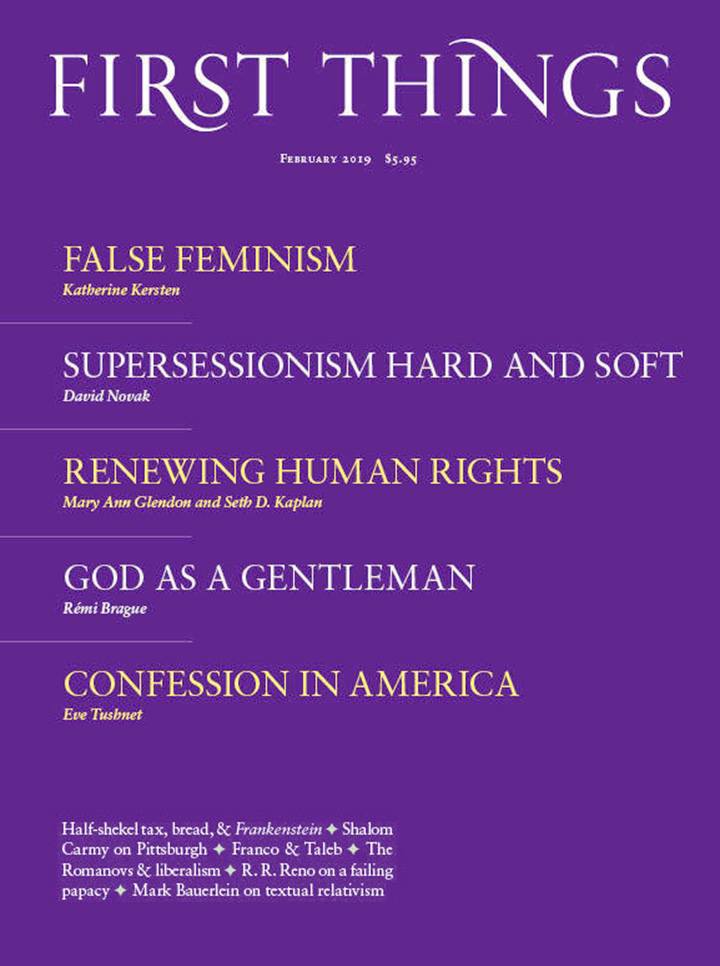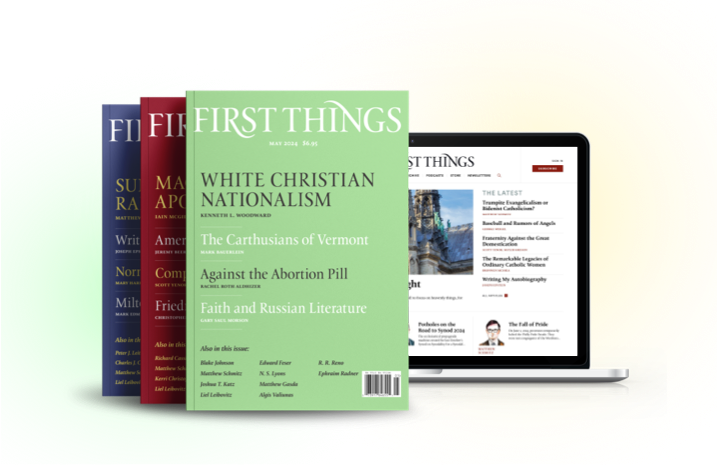The Lost History of Liberalism:
From Ancient Rome to the Twenty-First Century
by helena rosenblatt
princeton, 368 pages, $35
Liberalism, says Helena Rosenblatt, has grown ineffective as it has forgotten the role that public morality, virtue, and conceptions of the common good played in its development. In order to reconnect with these sources while illuminating the history of liberalism itself, she narrates what she calls a word history, an account of “how liberals defined themselves and what they meant when they spoke about liberalism.” What emerges is a picture of the liberalism “virtually obsessed with the need for moral reform” from its birth at the Revolution of 1789 throughout its development, primarily in France and later in Germany and the United States.
Rosenblatt gives us a history of liberalism from the standpoint of liberals themselves. It is a story of liberalism’s liberality and generosity, a story by liberals for liberals, told just at the time that liberalism’s weaknesses have been exposed by a new, robust nonliberalism. This story diverges from the one that mid-century liberals fashioned to account for their own success, when they patched together the old common law and the political philosophy of John Locke to set liberal institutions on an individualist foundation. Later attempts to craft a liberalism neutral on the content of the public good were, in Rosenblatt’s view, unfaithful to liberalism’s origins. Hers is no longer the story of a triumphant liberalism, but of an endangered liberalism in need of ressourcement.
This is only the self-congratulating half of the story. For the early French liberals, moral reform meant preserving the anti-ecclesiastical gains of the Revolution: écrasez l’infâme met with initial success, and those successes had to be preserved by separating morality from ecclesiastical instruction. “For liberals like Madame de Staël and Benjamin Constant,” Rosenblatt observes, “the Church simply could not be trusted to promote the moral regeneration of the republic.” This renewal was not a straightforward or uncontested goal of the liberals; instead, it was a kind of code for upending all remaining elements of ecclesiastical authority. Liberalism did not have to offer a comprehensive way of life. It simply had to define traditional ecclesiastical authority as the locus of moral degeneration in order to establish itself as the representative of “moral regeneration.”
Counterrevolutionary writers pointed out this sleight of hand. Louis de Bonald criticized the transformation of liberal from describing generosity to justifying attacks on the Church. Rosenblatt bristles at these criticisms, complaining that Pierre Manent’s intellectual history of liberalism, for example, “is the now two-hundred-year-old Catholic critique repackaged.” But while Rosenblatt interprets early French liberalism in the light of “liberality” to inspire a similar recasting of contemporary liberalism, liberalism’s anti-ecclesiastical stance lies at the heart of her story. “What France needed,” the liberals thought, “was not Catholicism but an enlightened religion that fostered the qualities of mind and character necessary for good citizenship.”
The anti-ecclesiastical stance grew even stronger during the Bourbon Restoration and particularly under Charles X. “Liberals protested loudly, more than ever convinced that the Catholic Church was their most formidable enemy,” she writes. “It has been estimated that over the span of seven years, 2.7 million anticlerical books were published, including Constant’s De la religion.” Whatever its long-term ambitions, liberalism in its initial stages required a wholesale reengineering of ecclesiastical establishments where they stood in the way, and an adversarial stance against retrograde theological and ecclesiastical tendencies wherever they appeared.
Amid the countless other variations on liberalism, this anti-ecclesiastical stance remained constant, a sine qua non of all subsequent developments within liberal politics. Rosenblatt shows well the variety of liberal stances on matters such as the desirability of revolutions, the question of empire, and the state’s role in directing economic development and responding to social ills. The “great majority of nineteenth-century liberals” accepted a range of state intervention in the economy and “denounced selfishness and individualism at every opportunity.” Yet even in lands such as Germany and Britain that had already confronted the question of the Church during the Reformation, liberals continued to take anti-ecclesiastical and anti-Catholic stances. Authors of the Staats-Lexikon, “a veritable compendium of liberal beliefs,” not only declared the pope the “worst enemy of the German nation,” but also attacked the “superstition, darkness, ignorance, hierarchical despotism and intolerance” of revanchist Protestantism.
Rosenblatt frequently gives this anti-ecclesiastical fixation a wholesome gloss. While admitting that liberals longed to replace the established churches with what J. C. L. de Sismondi called a “rational and liberal religion,” she complains that the idea that liberals rejected the common good “is what their enemies said about them, not what they said about themselves.” Yet if liberals were fighters from the beginning, presumably it matters what their opponents thought. Notwithstanding liberal discourse about morality and the common good, in practice liberals sought the disestablishment and replacement of the common goods that had grounded prerevolutionary society.
In her tour of the anti-ecclesiastical elements of liberalism, Rosenblatt in fact provides the material needed for a more balanced story of liberalism. But the fuller account is less encouraging for those inclined to attempt a ressourcement. If liberalism’s “moral” devotion is oriented toward replacing traditional institutions, then it will always adopt an aggressive, imperialist stance. Her narrative of liberalism is so one-sided that her list of its victims excludes its primary foe: the Church. While she plaintively admits that liberals “were capable of excluding entire groups of people from their liberal vision,” she does not consider the ecclesiastical establishment unfairly excluded.
Liberalism’s project of moral edification culminated in France with what Rosenblatt calls a “battle” to wrest control of education from the Church and replace it with a model inspired by the American public school. “It is not hard to see,” she writes, “that the liberal system of education championed by the educational reformers was overtly anti-Catholic. Its designers never hid the fact that its purpose was to detach the population from priests.” This transformed French education along specifically liberal lines, orienting schools toward “free thought” instead of scholasticism and “self-government” instead of the classical notions of duty of state and, properly understood, obedience.
Liberal schools emphasized qualities such as industriousness and creativity that would enable the construction of a society oriented around a progressively expanding liberty alongside the rational, technological control of nature. Rosenblatt shows that liberals countenanced all manner of state action beyond those permitted under strict laissez-faire approaches. Nevertheless, their actions still aimed to bring about a political situation directed neither by ecclesiastical concerns nor by traditional ways of life but rather by aspirations toward an ever more liberal future.
It is ironic that Rosenblatt’s effort to recover a liberal “morality” oriented toward the common good comes at a time of heightened moralism on the part of contemporary liberalism. To be sure, today’s liberals exercise their moralism on behalf of increasingly narrow causes. But liberal moralism is not exactly lacking today.
The political development of Europe,” Pierre Manent once wrote, “is understandable only as the history of answers to problems posed by the Church.” The Lost History of Liberalism reinforces Manent’s observation even while Helena Rosenblatt colors the goals of early liberalism in golden hues. However noble early liberalism’s project of moral improvement may have been, its self-perception always included the specific aim of overthrowing the Church. As that institution has suffered under liberal advances, so has the morality and liberality that liberals claim they want to secure.
Though this is hardly its intention, The Lost History of Liberalism offers a counterpoint to the hopes of Catholics seeking rapprochement with liberalism. In spite of her best efforts to make liberalism’s interest in public morality stand on its own two feet, Rosenblatt shows that liberal public morality is always in opposition to the accounts of morality and public life offered by the Church. Liberals have never been seriously interested in the ways Catholics have sought to make peace with liberalism. The more liberals return to their roots, the more apparently shared ground will give way. The future lies in anti-ecclesiastical liberal ressourcement on the one hand, and anti-liberal ecclesiastical ressourcement on the other.
Gladden J. Pappin is assistant professor of politics at the University of Dallas and deputy editor of American Affairs.
The Bible Throughout the Ages
The latest installment of an ongoing interview series with contributing editor Mark Bauerlein. Bruce Gordon joins in…
Redemption Before Christ
The latest installment of an ongoing interview series with contributing editor Mark Bauerlein. Gerald R. McDermott joins…
The Theology of Music
Élisabeth-Paule Labat (1897–1975) was an accomplished pianist and composer when she entered the abbey of Saint-Michel de…


